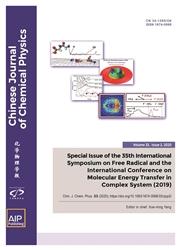MgF的高分辨激光激发光谱和A2π−X2∑+电子跃迁的Franck-Condon因子
IF 1.2
4区 化学
Q4 PHYSICS, ATOMIC, MOLECULAR & CHEMICAL
引用次数: 5
摘要
单氟化镁(MgF)是一种理想的激光直接冷却自由基。本文利用激光诱导荧光技术记录了A2Π−X2Σ+电子跃迁体系中MgF的旋转分辨激光光谱。在超声速射流膨胀过程中,在两根镁针针尖间释放SF6/Ar混合气体,产生MgF自由基。在348 ~ 370 nm范围内共记录了19个振动带,分别属于Δ v=0,±1三个序列。通过对实验光谱的旋转分析,确定了X2Σ+和A2Π态的精确光谱常数。光谱参数包括frank - condon因子(ffs),由实验结果和Rydberg-Klein-Rees (RKR)计算确定。实验测量的ffs与rkr计算的ffs之间存在显著差异,表明在A2Π状态下,ffs几乎与自旋-轨道耦合无关。本文确定的势能曲线(PECs)和ffs为MgF激光冷却方案的理论模拟提供了必要的数据。本文章由计算机程序翻译,如有差异,请以英文原文为准。
High resolution laser excitation spectra and Franck-Condon factors of A2Π−X2Σ+ electronic transition of MgF
Magnesium monofluoride (MgF) is proposed as an ideal candidate radical for direct laser cooling. Here, the rotationally resolved laser spectra of MgF for the A2Π− X2Σ+ electronic transition system were recorded by using laser induced fluorescence technique. The MgF radicals were produced by discharging SF6/Ar gas mixtures between the tips of two magnesium needles in a supersonic jet expansion. We recorded a total of 19 vibrational bands belonging to three sequences of Δ v=0, ±1 in the region of 348-370 nm. Accurate spectroscopic constants for both X2Σ+ and A2Π states are determined from rotational analysis of the experimental spectra. Spectroscopic parameters, including the Franck-Condon factors (FCFs), are determined from the experimental results and the Rydberg-Klein-Rees (RKR) calculations. Significant discrepancies between the experimentally measured and RKR-calculated FCFs are found, indicating that the FCFs are nearly independent of the spin-orbit coupling in the A2Π state. Potential energy curves (PECs) and FCFs determined here provide necessary data for the theoretical simulation of the laser-cooling scheme of MgF.
求助全文
通过发布文献求助,成功后即可免费获取论文全文。
去求助
来源期刊

Chinese Journal of Chemical Physics
物理-物理:原子、分子和化学物理
CiteScore
1.90
自引率
10.00%
发文量
2763
审稿时长
3 months
期刊介绍:
Chinese Journal of Chemical Physics (CJCP) aims to bridge atomic and molecular level research in broad scope for disciplines in chemistry, physics, material science and life sciences, including the following:
Theoretical Methods, Algorithms, Statistical and Quantum Chemistry
Gas Phase Dynamics and Structure: Spectroscopy, Molecular Interactions, Scattering, Photochemistry
Condensed Phase Dynamics, Structure, and Thermodynamics: Spectroscopy, Reactions, and Relaxation Processes
Surfaces, Interfaces, Single Molecules, Materials and Nanosciences
Polymers, Biopolymers, and Complex Systems
Other related topics
 求助内容:
求助内容: 应助结果提醒方式:
应助结果提醒方式:


